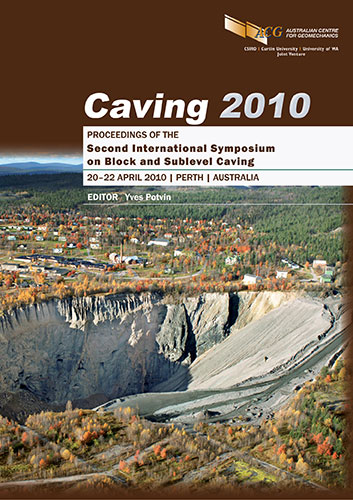Block 4 geotechnics — past, present and future

|
Authors: Preece, CA Paper is not available for download Contact Us |
DOI https://doi.org/10.36487/ACG_rep/1002_24_Preece
Cite As:
Preece, CA 2010, 'Block 4 geotechnics — past, present and future', in Y Potvin (ed.), Caving 2010: Proceedings of the Second International Symposium on Block and Sublevel Caving, Australian Centre for Geomechanics, Perth, pp. 341-357, https://doi.org/10.36487/ACG_rep/1002_24_Preece
Abstract:
Whilst the Finsch orebody had been mined for over 30 years, additional data was required prior to implementation of the Block 4 project on all rock types and the groundwater regime. Due to similarities in the ore bodies, the initial Block 4 layout was based on the cave designs being employed at Cullinan Mine, BB1 East. The country rock development proved adequate but it became clear from the initial drilling, blasting and support in the kimberlite that standards were inadequate; a combination of worse than expected ground conditions and lack of experience of the development teams in working in kimberlite. The project team embarked on a major training programme and introduced stringent quality control measures. Due to the detrimental effect of water on the Finsch kimberlite a dewatering system had to be developed and implemented so that groundwater was prevented from entering the muckpile once the cave became operational. This work brought together the skills of consultants, contractors and a dedicated mine team and culminated in the development and equipping of seven 200 m deep wells some 650 m below surface. The optimum undercut orientation, south east to northwest, was obtained by computer modelling. The extraction sequence was scheduled in detail, attention being paid to the timing of the drawbell construction and commissioning on the production level. A semi-automated draw control system, utilising the programmes PCBC and CMS from GEMCOM, PCS and instrumented load–haul–dump units (LHDs) from Sandvik was selected. Undercutting operations and drawbell construction and commissioning proceeded as planned, with at times the monthly call being exceeded. The final stages of undercutting involved traversing a weak mudstone and as the western contact was approached significant deformation occurred on the undercut level starting at tunnel 17. Tunnel rehabilitation had to be undertaken and the undercut face re-established. Pillars had to be left and these were probed and blasted from the extraction level. Within a short time deformation was observed in Tunnel 8 on the extraction level and eventually 6 drawpoints were lost. The undercut was successfully completed on 12 December 2008 and the last drawpoint commissioned in late April 2009. The production build up took place according to rules embedded in PCBC and since April 2009, 349 drawpoints have been in production. Despite the strict draw control policies rat holing through to the pit floor has occurred and allowed the early ingress of waste. To date over 59,000 tonnes have been drawn through the oldest drawpoint and no deterioration or brow wear has been observed. Ongoing monitoring and observations have shown that the support systems installed have performed as required and that no significant deformation has been recorded. Twenty million tonnes remain to be drawn from Block 4 and at this stage no major problems are anticipated other than continued waste ingress. Overall the planning, implementation and production have been highly successful.
References:
Barnett, W.P. (1997) The Structural and Engineering Geology of the Country Rock at Finsch Mine, unpublished MSc Thesis, University of Cape Town.
Beaton, R., Morton, K.L., Preece, C.A., Twiggs, C.J. and Wilson, A.D. (2007) Block Cave Dewatering: A Case History from De Beers Finsch Mine, in Proceedings 1st International Symposium on Block and Sub-Level Caving, Cave Mining, SAIMM, Cape Town, pp. 239–264.
Diering, T. (2000) PC-BC: A block cave design and draw control system, in Proceedings of MassMin 2000, Brisbane, Australia, pp. 469–484.
Esterhuizen, G.S. (1994) A programme to predict block cave fragmentation, technical reference and users guide, version 2.1.
Hoek, E. and Brown, E.T. (1982) Underground excavations in rock, IMM, p. 132.
Laubscher, D.H. (1994) Cave Mining – the state of the art, Journal of SAIMM, October 1994, pp. 279–293.
Laubscher, D.H. (1990) A geomechanics classification system for the rating of rock mass in mine design, Journal of SAIMM, Vol. 90, No. 10, October 1990, pp. 257–273.
Morton, K.L. and Preece, C.A. (2000) Data Collection and Aquifer Structure of Finsch Mine, Groundwater: Past achievements and future challenges, International Association of Hyrogeologists, O. Sililo (ed), Cape Town.
Preece, C.A. (2001) Finsch Mine Open Pit to Open Stoping to Block Cave Operation, SME, W.A. Hustrulid and R.L. Bullock (eds), pp. 439–444.
Preece, C.A. and Liebenberg, B. (2007) Cave Management at Finsch Mine, in Proceedings 1st International Symposium on Block and Sub-Level Caving, Cave Mining, SAIMM symposium series S49, Cape Town, pp. 147–160.
Preece, C.A. and Wilson, A.D. (2009) Shotcrete as a support medium for tunnels developed in kimberlite at De Beers Finsch Mine, SAIMM symposium series S55, Gauteng, pp. 209–220.
Talu, M.S. and Wilson, A.D. (2004) Innovative mining method, related support systems and quality assurance for large underground crusher excavation De Beers Finsch Mine, South Africa, in Proceedings MassMin 2004, Santiago, pp. 356–361.
Wilson, A.D. and Talu, M.S. (2004) A review of the support systems being applied to the Block 4 Cave project of De Beers Finsch Mine, South Africa, in Proceedings MassMin 2004, Santiago, pp. 350–355.
© Copyright 2025, Australian Centre for Geomechanics (ACG), The University of Western Australia. All rights reserved.
View copyright/legal information
Please direct any queries or error reports to repository-acg@uwa.edu.au
View copyright/legal information
Please direct any queries or error reports to repository-acg@uwa.edu.au